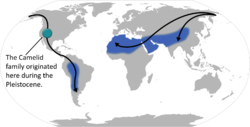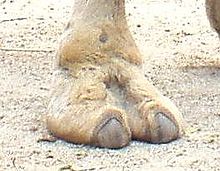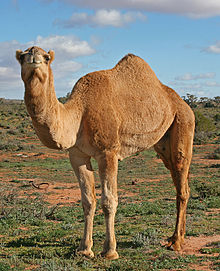- Camelid
-
Camelid
Temporal range: 45–0 Ma Middle Eocene-Recent
A Bactrian Camel walking in the snow Scientific classification Kingdom: Animalia Phylum: Chordata Class: Mammalia Order: Artiodactyla Suborder: Tylopoda Family: Camelidae
Gray, 1821Genera Lama
Vicugna
Camelus
Map of the world showing distribution of camelids, prior to modern introductions to Australia and elsewhere. Solid black lines indicate possible migration routes. Camelids are members of the biological family Camelidae, the only living family in the suborder Tylopoda. Dromedaries, Bactrian Camels, llamas, alpacas, vicuñas, and guanacos are in this group.
Camelids are even-toed ungulates: they are classified in the order Artiodactyla, along with pigs, hippopotamus, deer, giraffes, cattle, goats, antelope,and many others.
Contents
Characteristics
 Camelid feet lack functional hooves, the toe bones being embedded in a broad cutaneous pad[1]
Camelid feet lack functional hooves, the toe bones being embedded in a broad cutaneous pad[1]
Camelids are large animals with slender necks and long legs, and are strictly herbivorous. Camelids differ from true ruminants in a number of ways. Their dentition shows traces of vesitigial central incisors in the upper jaw, and the third incisors are developed into canine-like tusks. Camelids also have true canine teeth and tusk-like premolars which are separated from the molars by a gap. The musculature of the hind limbs differs from those of other ungulates by the fact that the legs are attached to the body at the top of the thigh only, rather than attached by skin and muscle from the knee downwards. Because of this, camelids have to lie down by resting on their knees with their legs tucked underneath the body.[1] They have a three-chambered rather than a four-chambered digestive tract, an upper lip that is split in two with each part separately mobile, and uniquely among mammals, elliptical red blood cells. They also have a unique type of antibodies lacking the light chain, in addition to the normal antibodies found in other mammals. These so-called heavy-chain antibodies are being used to develop single-domain antibodies with potential pharmaceutical applications.
They do not have hooves, rather a two-toed foot with toenails and a soft footpad (Tylopoda is Latin for "padded foot"). The main weight of the animal is borne by these tough, leathery sole-pads. The South American camelids, adapted to steep and rocky terrain, can move the pads on their toes to maintain grip.[2] Many fossil camelids were unguligrade and probably hooved, in contrast to all living species.[3]
The two Afro-Asian camel species have developed extensive adaptations to their life in harsh, near-waterless environments. Wild populations of the bactrian camel are even able to drink brackish water, and some herds live in nuclear test areas.[4]
Evolution
Camelids are unusual in that their modern distribution is almost a mirror-image of their origin. Camelids first appeared very early in the evolution of the even-toed ungulates, around 45 million years ago during the middle Eocene, in present-day North America. Among the earliest camelids was the rabbit-sized Protylopus, which still had four toes on each foot. By the late Eocene around 35 million years ago, camelids such as Poebrotherium had lost the two lateral toes, and were about the size of a modern goat.[3][5]
The family diversified and prospered but remained confined to the North American continent until only about 2 or 3 million years ago, when representatives arrived in Asia, and (as part of the Great American Interchange that followed the formation of the Isthmus of Panama) South America.
The original camelids of North America remained common until the quite recent geological past, but then disappeared, possibly as a result of hunting or habitat alterations by the earliest human settlers, but more likely as a result of changing environmental conditions after the last Ice Age. Three species groups survived: the Dromedary of northern Africa and south-west Asia; the Bactrian Camel of central Asia; and the South American group, which has now diverged into a range of forms that are closely related but usually classified as four species: Llamas, Alpacas, Guanacos, and Vicuñas.
Fossil camelids show a wider variety than their modern counterparts. One North American genus, Titanotylopus, stood 3.5 metres at the shoulder, compared with the approximately two metres of the largest modern camelids. Other extinct camelids included small, gazelle-like animals, such as Stenomylus. Finally, there were a number of very tall, giraffe-like camelids, adapted to feeding on leaves from high trees, including such genera as Aepycamelus, and Oxydactylus.[3]
Scientific classification
- ORDER ARTIODACTYLA
- Suborder Suina
- Suborder Ruminantia
- Suborder Tylopoda
- †Family Xiphodontidae
- †Family Protoceratidae
- †Family Oromerycidae
- †Family Merycoidodontidae
- Family Camelidae
- †Subfamily Poebrodontinae
- †Subfamily Poebrotheriinae
- †Subfamily Miolabinae
- †Subfamily Stenomylinae
- †Subfamily Floridatragulinae
- Subfamily Camelinae
- Tribe Lamini
- Tribe Camelini
- Genus: Camelus
- Dromedary, Camelus dromedarius
- Bactrian Camel, Camelus bactrianus
- †Syrian Camel
- †Camelus gigas
- †Camelus hesternus
- †Camelus sivalensis
- Genus: Camelus
Phylogenetic tree
Camelid ancestor North America 12-25 mya
Lamini 10.4 mya 1.4 mya Guanaco South America Vicuña Camelini 8 mya Bactrian camel Asia Dromedary Asia, Africa Extinct genera of camelids
Genus name Epoch Remarks Aepycamelus Miocene Tall, s-shaped neck. True padded camel feet. Camelops Pliocene-Pleistocene Large, with true camel feet. Hump status uncertain. Floridatragulus Early Miocene A bizarre species of camel with a long snout Eulamaops Pleistocene From South America Hemiauchenia Miocene-Pleistocene A North and South American lamine genus Megacamelus Miocene-Pleistocene The largest species of Camelid Megatylopus Miocene-Early Pleistocene Large camelid from North America Oxydactylus Early Miocene The earliest member of the "giraffe camel" family Palaeolama Pleistocene A North and South American lamine genus Poebrotherium Oligocene This species of camel took the place of deer and antelope in the White River Badlands. Procamelus Miocene Ancestor of extinct Titanolypus and modern Camelus. Protylopus Late Eocene Earliest member of the camelids Stenomylus Early Miocene Small, gazelle-like camel that lived in large herds on the Great Plains. Titanotylopus Miocene-Pleistocene Tall, humped, true camel feet. The newly discovered giant Syrian Camel is yet to be officially described.
References
- ^ a b Clutton-Brock, Juliet (1987). A Natural History of Domesticated Mammals. pp. 208. ISBN 0521346975.
- ^ Franklin, William (1984). Macdonald, D.. ed. The Encyclopedia of Mammals. New York: Facts on File. pp. 512–515. ISBN 0-87196-871-1.
- ^ a b c Savage, RJG, & Long, MR (1986). Mammal Evolution: an illustrated guide. New York: Facts on File. pp. 216–221. ISBN 0-8160-1194-X.
- ^ Wild Bactrian Camels Critically Endangered, Group Says National Geographic, 3 December 2002
- ^ Palmer, D., ed (1999). The Marshall Illustrated Encyclopedia of Dinosaurs and Prehistoric Animals. London: Marshall Editions. pp. 274–277. ISBN 1-84028-152-9.
External links
Categories:- Camelids
- ORDER ARTIODACTYLA
Wikimedia Foundation. 2010.


